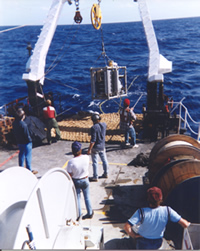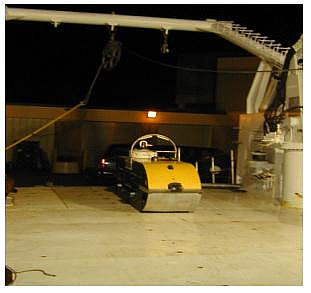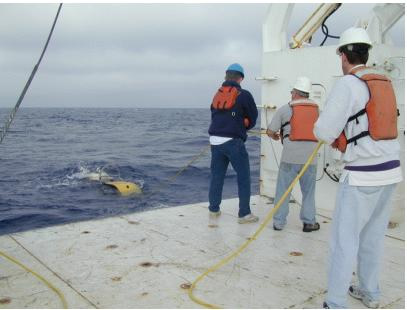In addition to the information provided here, a full listing of project related publications and presentations as well as a listing of funded students can be found in the Methane Hydrate Program Bibliography [PDF].
Final Cruise Report [PDF-9358KB] - November, 2005 - Naval Research Laboratory
Seismic Indications of Marine Hydrates
Seismic reflection surveys are the principal method for quickly assessing broad submarine areas for the presence of gas hydrates. A marine seismic survey is typically carried out from a ship that tows an energy (sound) source and a recording cable. The sea floor and the structures beneath it, are mapped by measuring the time it takes for a sound wave (or pulse) to leave the source, penetrate the earth, reflect off a subsurface layer, and return to a recording hydrophone on the cable. Reflections occur at each subsurface horizon where there is a measurable change in acoustic velocity (the speed at which sound is transmitted).
The energy transmitted in seismic surveys takes the form of compressional waves (P-waves) and shear waves (S-waves). As the P-wave moves through a substance the particles move back and forth in the same direction the wave is traveling (analogous to the compression and expansion of the coils in a Slinky toy spring). P-waves can travel through solids, liquids, or gases (e.g., sound waves are P-waves in air) and travel faster than S-waves. With the slower S-waves the particles move at right angles to the direction of the wave (analogous to the wave that moves along a rope when one end is oscillated). Because liquids and air have no shear strength, S-waves can only travel through solids. Marine seismic sound sources generate only P-waves, but some of the energy is converted to S-wave energy as the sound travels downward into the subsurface, encounters a sedimentary layer, and is reflected back as both P- and S-wave energy. Recording both reflections allows a better interpretation of the structure and the fluids present.
A Helmholtz resonator is used to generate seismic waves for the NRL deep-tow system. On the recording cables are pressure-sensitive receivers (hydrophones) that detect the instantaneous change in water pressure associated with the seismic signal. These cables can be designed to capture single channel or multichannel data. Single-channel seismic data (SCS) provide excellent images of hydrate/gas deposits but do not record seismic velocities. Multichannel seismic data (MCS), collected with multiple cables, can image structures and provide velocity information.
Marine seismic data can be collected in either two dimensions (2-D) or three dimensions (3-D). Seismic surveys in 2-D collect data along a single line of receivers. The result is a view of the subsurface as a two-dimensional slice of the earth directly below the geophones. However, because sound travels outward in all directions, features, structures, and irregularities not directly under the line also reflect sound, making accurate interpretations difficult. In contrast, 3-D seismic surveys use a grid of geophones that allows the entire wave field to be sampled. This design results in a cube of data that takes into account the different angles and distances of the reflected waves. Researchers then use computer work stations to view the subsurface along any plane desired.
Researchers are now developing ways to discern the presence, and also distribution, of hydrates from seismic data. This is possible because the presence of gas hydrates tends to strengthen the sediment, increasing its rigidity. This increase in rigidity causes the velocity of P-waves to increase as they move through the hydrate-bearing sediment Even when hydrate concentrations are low, the increased seismic velocity can often be detected.
Two seismic phenomena related to the occurrence of hydrate have been identified: the bottom simulating reflector (BSR), and a reduction in reflection amplitude, called blanking. Seismic lines from deep continental shelves all around the world contain anomalous reflections known as BSRs. The reflections mimic the sea-floor topography at a near constant depth below the surface, and commonly cut across geological layers. The nature of the reflection indicates a horizon across which seismic velocity dramatically decreases. Once the existence of natural methane hydrate was established, BSRs were thought to record the decrease in velocity when passing from hydrate-bearing sediments to those containing only water. Accordingly, BSRs were thought to be a direct indicator of hydrate: no BSR meant no hydrate. However, the velocity contrast between hydrate and no-hydrate was determined to be insufficient to cause BSRs. Currently, researchers believe that BSRs are an indication of a free methane gas phase that is blocked from further upward migration by the methane hydrate present in overlying layers. Consequently, BSRs may mark only a subset of the areas containing hydrate.
Geophysical modeling indicates that the presence of hydrate results in uniform higher velocity with reduced internal acoustic contrasts (reduced acoustic impedance). This character is manifested on seismic sections as a reduction or weakening of the amplitude of the seismic reflections. Typically the zone of hydrate above the BSR exhibits few reflections, and appears as a featureless region on the seismic cross section. In lieu of actual measurements from core samples, both relative seismic velocity and the degree of blanking have been used as indicators of gas hydrate concentrations. Velocities of compressional and shear waves recorded by multichannel seismic surveys also provide information on the hydrate concentration in sediments.






